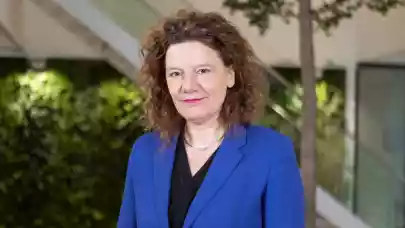
Property Forum talked to Carolien Gehrels, Global Director of Energy Transition at Arcadis, on the occasion of the RICS World Built Environment Forum – Europe event, where she was one of the keynote speakers.
Your keynote speech was titled „Is Europe ready for the circular economy?”. How would you summarise your answer to this question in two sentences?
Sure, Europe is ready! We have the agreements, and the coalitions of the willing and in cities there is so much to achieve, regarding the fact that almost 80% of all energy is spent in cities. Some examples to make cities more circular: combine mobility and energy hubs at the ring roads of our cities, and look where functions can be combined, for example, the steam, warmth and heat of the industries can be used for other offices and district heating. And combine new housing with public transport, then you don’t need a car anymore. Many cities have their roadmaps to net zero in place and now it is about the art of implementing.
Our industry has made the first steps in the right direction but there’s still a long way to go. What do you think needs to change for real estate owners and operators to take into account the whole lifecycle of a building by default?
Well, a building by default can have different lives in different locations. It is possible to make it almost energy-neutral, with solar panels, heat pumps and district heating. Mobility is an important aspect as well: in the Netherlands, we bike a lot, public transport is good and the number of electric cars is growing. And the materials you use in a building are getting more and more circular. Our new Arcadis Headquarters in Amsterdam will have a skeleton of wood, a lot of green spaces, we use circular materials in the concrete and water buffering so you can use rainwater for the toilet flushing.
In the current economic environment, many industry actors are reluctant to invest in anything, including improving energy efficiency. What advice would give them?
I’m a little bit more optimistic. Thanks to the European Trade System in carbon the industry must be net zero in 2040. I see a lot of industries starting with carbon capture storage and looking to electrification and hydrogen instead of natural gas. There will grow a market for renewables and that will replace fossils. We saw in our offshore wind projects on the North Sea that once you have reached your economy of scale, it will be cheaper and cheaper as well. So, I hope that in the next years, we will make big jumps forward.
What are some of the technologies/solutions in the built environment industry you’re most excited about right now?
I love to take a big building as a starting point, for example, a soccer stadium of a convention centre or a big building in a business district. There it is possible to work with an integrated approach and combine the energy demand and supply with mobility. Densification gives the opportunity to make the whole neighbourhood more sustainable in a cost-effective way: when you add real estate you add value which can be used to make the other buildings more sustainable or to electrify the mobility streams. Exiting in the chemical industry is to crack molecules into different ones: in the end, it is all about O, H, C and N’s and you can combine them in many ways.
Dutch cities are global leaders when it comes to sustainable placemaking. What is one solution/practice that you think every city should adopt?
Start the collaboration with a coalition of the willing and ask people with different perspectives, backgrounds and experiences. Check what the shared long-term vision for your city is, for 2050 for example and see what is needed to get there! And give the citizens and companies the time to adapt, transition is not what happens overnight. For example, we said to the canal boat operators here in Amsterdam in 2010 that they had to electrify before 2020. They had the time to make that transition in ten years, step by step and to use the natural replacement moments you always have in a heavy asset company. And try to live with nature, in our country with the water instead of fighting against it. Create room for the river, buffer the rainwater, and protect the cities by natural levies and dikes which can have other functions as parks or parking places as well. And last but not least: measure the progress, in terms of air quality, energy consumption, and noise so you can show the progress to your citizens and they are part of the success!
Outside of your home country, which are some of the European cities where you find inspiration when it comes to creating resilient and future-proof cities?
Traditionally the Scandinavian cities are doing a great job, with a lot of green spaces, less air pollution due to electrification, good public transport and citizen involvement in the neighbourhoods. In Vienna, Austria they introduced the smart city concept in 2011 and integrated new digital and intelligent solutions from the beginning. Cities in Italy are also very active in data-driven improvement of the quality of life in cities and as long as there are many monumental buildings from centuries ago, they are very sustainable as well because they have been used and reused over more than thousands of years now and then. That is very sustainable as well.



